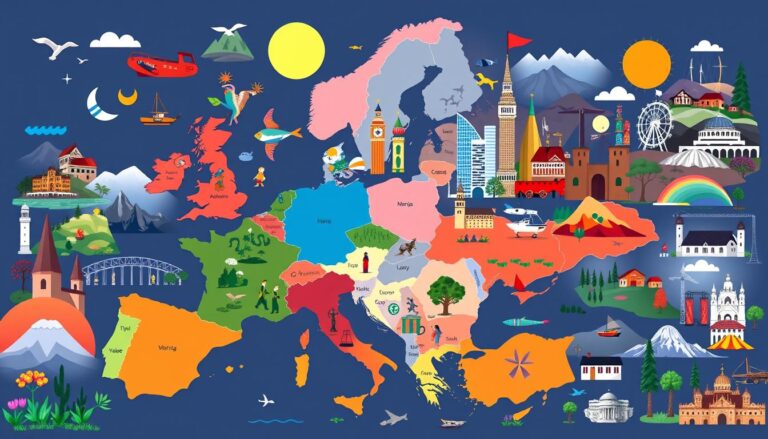When considering the most populous of all European Union countries, you immediately think of Germany. According to the latest population projections for 2024, Germany proudly stands as the largest country in the European Union by population, boasting a remarkable population of about 84,552,242 individuals. This vibrant country embodies a significant 1.04% share of the global population, a testament to its dynamic society and economic prowess.
Germany not only leads among the most populous EU nations but also displays demographic stability. With an annual population change of virtually 0.00%, it maintains a steady pace in demographic terms. The country exhibits an impressive population density of 243 people per square kilometre, illustrating the prevalence of well-organised urban centres and thriving communities.
Delving deeper into the EU population statistics reveals that Germany surpasses its European neighbours by a substantial margin. Close behind is France, with a population of 68,402,000, accounting for 15.2% of the EU population. Italy follows suit with 58,989,700 inhabitants, representing 13.1% of the collective EU demographic.
Moving further, Spain and Poland also feature significantly, with populations of 48,610,500 and 36,621,000, respectively. They contribute 10.8% and 8.2% to the overall EU population, showcasing the diverse and rich tapestry of cultures within the European Union.
The interesting aspect of Germany is its ageing population, marked by a median age of 45 years. This presents both challenges and opportunities within the national border. For instance, a substantial segment of Germany’s population resides in urban areas, with urbanisation standing at 76%. Such a high degree of urban living underscores the significance of cities like Berlin, Munich, and Hamburg in shaping the country’s social and economic landscape.
As you explore further, you will discover that Germany’s demographic profile is also shaped by its net migration rate, which stands at 36,954 migrants, and a fertility rate of 1.4 children per woman. Both metrics highlight the delicate balance Germany maintains in sustaining its population dynamics amidst global trends. Additionally, the country’s vast land area of 348,560 square kilometres ensures ample space for its citizens, contributing to their high quality of life.
In conclusion, Germany’s position as the most populous member state of the European Union is a fascinating blend of demographic stability, urbanisation, and ageing trends. Its status not only reflects historical and economic strengths but also points towards a vibrant future with numerous possibilities for growth, innovation, and cultural exchange within the broader context of European Union countries.
An Overview of the European Union’s Population
The European Union, a fascinating tapestry of nations, offers a diverse and dynamic profile of its residents. With a total population estimated at over 513 million as of January 1, 2019, the demographic landscape is rich and varied. This section will delve into the population distribution in Europe, the split between urban and rural populations, and the ever-intriguing population density in Europe.
Population Distribution
The disparity in population distribution in Europe is quite striking. Germany, home to 83.0 million people, holds the title of the most populated EU member state, accounting for 16.2% of the entire Union’s population. At the other end of the spectrum, Malta, the smallest EU country, boasts a population of just around 500,000. Additionally, while some countries have seen population growth—in particular, Malta with an increase of +36.8 per 1,000 residents—others, like Latvia, have faced decreases, evident in a reduction of -7.5 per 1,000 residents during the same period.
Urban vs Rural Populations
Urbanisation within the EU continues to shape its demographic outlook. Countries including Belgium and the Netherlands exhibit near-total urbanisation, with rates as high as 99% and 89% respectively. This phenomenon highlights how urban centres become magnets for opportunities, housing, and infrastructure. Conversely, rural areas, characterised by stagnant or declining populations, reflect an emerging trend where growth is primarily concentrated in urban locales.
Population Density in Europe
Population density in Europe reveals a continent of stark contrasts. Highly urbanised areas such as the Netherlands demonstrate notable density figures at 541 people per square kilometre, underscoring dense settlement patterns. However, regions like Finland spotlight the lower end of the spectrum with only 18 people per square kilometre, illuminating the sparse population spread across vast natural landscapes. This divergence in population density is a testament to the varied geographical and socio-economic frameworks within the European Union.
| Country | Population (million) | Population Density (P/Km²) | Urbanisation Rate (%) |
|---|---|---|---|
| Germany | 83.0 | 233 | 77 |
| Netherlands | 17.3 | 541 | 89 |
| Belgium | 11.5 | 383 | 99 |
| Finland | 5.5 | 18 | 83 |
Germany: The Largest Country in the European Union by Population
Germany stands out as the most populous country in the European Union, with an estimated population of around 84 million as of June 2024. This significant demographic footprint represents approximately 18.6% of the EU’s total population, making Germany a pivotal player in the EU’s economic and political landscapes. Understanding Germany’s position within country rankings in the EU underscores its crucial role in driving the region’s growth and stability.
When you consider the biggest EU countries by area, Germany’s demographic influence is even more pronounced due to the country’s population density and urbanisation. Major cities like Berlin, Munich, and Hamburg serve as vibrant hubs of economic activity, drawing a substantial portion of the population. These urban centres not only contribute to Germany’s economic prowess but also reflect the country’s robust infrastructure and high quality of life.
Despite an ageing population, with a median age of 45 years and a fertility rate of 1.4, Germany’s demographic stability is remarkable in the broader context of an ageing Europe. This stability ensures that Germany remains a cornerstone of the largest EU countries both in population and socio-economic impact. The country’s comprehensive healthcare system, strong educational institutions, and innovative economy play pivotal roles in maintaining its demographic strength.
As you delve deeper into country rankings in the EU, it becomes clear that Germany’s substantial and stable population underpins its status not only as a major demographic presence but also as a leader in the EU. The nation’s ability to attract and sustain a large population is indicative of its influential role within the union, making Germany an exemplary model in the realm of demographic and economic leadership among the biggest EU countries by area.

